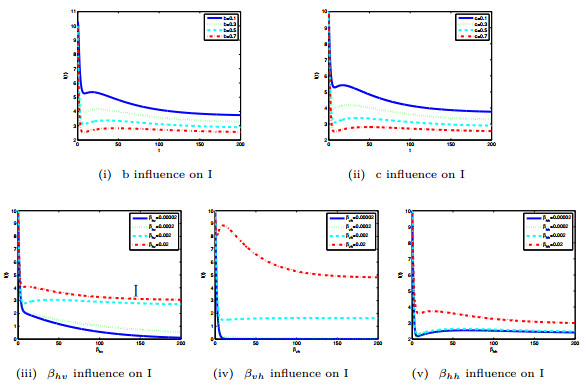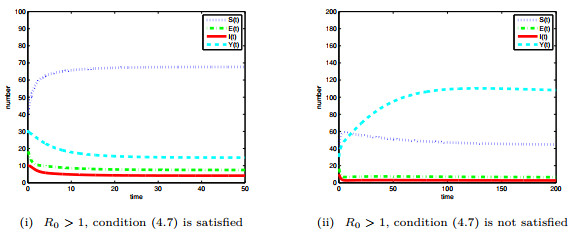|
[1]
|
L. Boiteux and L. Giordano, Genetic basis of resistance against two Tospovirus species in tomato (Lycopersicon esculentum), Euphytica, 1993, 71(1), 151-154.
Google Scholar
|
|
[2]
|
C. Brittlebank, Tomato diseases, J. Depar. Agri. Vict., 1919, 17, 1348-1352.
Google Scholar
|
|
[3]
|
G. Butler, H. Freedman and P. Waltman, Uniformly persistent systems, Proc. Amer. Math. Soc., 1986, 96(3), 425-430. doi: 10.1090/S0002-9939-1986-0822433-4
CrossRef Google Scholar
|
|
[4]
|
K. Chen, Z. Xu, L. Yan and G. Wang, Characterization of a new strain of Capsicum chlorosis virus from peanut (Arachis hypogaea L.) in China, J. Phyt., 2007, 155(3), 178-181.
Google Scholar
|
|
[5]
|
W. A. Coppel, Stability and Asymptotic Behavior of Differential Equations, Heath, Boston, 1965.
Google Scholar
|
|
[6]
|
N. Cunniffe and C. Gilligan, Invasion, persistence and control in epidemic models for plant pathogens: the effect of host demography, J. Roy. Soc. Inter., 2010, 7(44), 439-451. doi: 10.1098/rsif.2009.0226
CrossRef Google Scholar
|
|
[7]
|
A. Czech, M. Szklarczyk, Z. Gajewski, et al, Selection of tomato plants resistant to a local Polish isolate of tomato spotted wilt virus (TSWV), J. Appl. Genet., 2003, 44(4), 473-480.
Google Scholar
|
|
[8]
|
O. Diekmann, J. Heesterbeek and J. Metz, On the definition and the computation of the basic reproduction ratio $R_{0}$ in models for infectious diseases in heterogeneous populations, J. Math. Biol., 1990, 28(4), 365-382.
Google Scholar
|
|
[9]
|
M. Ding, Y. Luo, Q. Fang, Z. Zhang and Z. Zhao, First report of Groundnut yellow spot virus infecting Capsicum annuum in China, J. Plant Path., 2007, 89(2), 305.
Google Scholar
|
|
[10]
|
P. Driessche and J. Watmough, Reproduction numbers and sub-threshold endemic equilibria for compartmental models of disease transmission, Math. Bios., 2002, 180(1), 29-48.
Google Scholar
|
|
[11]
|
X. Feng, S. Ruan, Z. Teng and K. Wang, Stability and backward bifurcation in a malaria transmission model with applications to the control of malaria in China, Math. Bios., 2015, 266, 52-64. doi: 10.1016/j.mbs.2015.05.005
CrossRef Google Scholar
|
|
[12]
|
L. Ferrand, M. M. S. Almeida, et al, Biological and molecular characterization of tomato spotted wilt virus (TSWV) resistance-breaking isolates from Argentina, Plant Pathology, 2019, 68(9), 1587-1601. doi: 10.1111/ppa.13087
CrossRef Google Scholar
|
|
[13]
|
F. R. Gantmacher, The theory of matrices, Amer. Math. Soc., New York, 1959.
Google Scholar
|
|
[14]
|
R. Gupta1, S. Kwon and S. Kim, An insight into the tomato spotted wilt virus (TSWV), tomato and thrips interaction, Plant Biot. Repo., 2018, 12(3), 157-163. doi: 10.1007/s11816-018-0483-x
CrossRef Google Scholar
|
|
[15]
|
J. Hale, Asymptotic behavior of dissipative systems, Bull. Amer. Math. Soc., 1990, 22, 175-183. doi: 10.1090/S0273-0979-1990-15875-6
CrossRef Google Scholar
|
|
[16]
|
M. Jeger, F. Van den Bosch and N. McRoberts, Modelling transmission characteristics and epidemic development of the tospovirus-thrip interaction, Arth.-Plant Interactions, 2015, 9(2), 107-120. doi: 10.1007/s11829-015-9363-2
CrossRef Google Scholar
|
|
[17]
|
J. Jia and J. Xiao, Stability analysis of a disease resistance SEIRS model with nonlinear incidence rate, Adv. Diff. Equa., 2018, DOI: 10.1186/s13662-018-1494-1.
CrossRef Google Scholar
|
|
[18]
|
Y. Kuang, D. Ben-Arieh, S. Zhao and C. Wu, Using spatial games to model and simulate tomato spotted wilt virus-western flowers thrip dynamic system, Int. J. Mode. Simu., 2018, 38(4), 243-253.
Google Scholar
|
|
[19]
|
M. Li and J. Muldowney, On R.A. Smith's autonomous convergence theorem, Rock. moun. J. math., 1995, 25(1), 365-379. doi: 10.1216/rmjm/1181072289
CrossRef Google Scholar
|
|
[20]
|
M. Li and J. Muldowney, A geometric approach to global stability problems, SIAM J. Math. Anal., 1996, 27(4), 1070-1083.
Google Scholar
|
|
[21]
|
Y. Li, Z. Zhang, S. Guan, H. Pen, J. Li and Y. Zou, Kinds of tobacco viral pathogens and the infection cycle at Binchuan county, J. Yunnan Agri. Univ., 1997, 12(4), 263-268.
Google Scholar
|
|
[22]
|
S. Morsello, A. Beaudoin, R. Groves, et al, The influence of temperature and precipitation on spring dispersal of Frankliniella fusca changes as the season progresses, Ento. Expe. Appl., 2010, 134(3), 260-271. doi: 10.1111/j.1570-7458.2009.00959.x
CrossRef Google Scholar
|
|
[23]
|
R. Olatinwo, J. Paz, S. Brown, et al, A predictive model for spotted wilt epidemics in peanut based on local weather conditions and the tomato spotted wilt virus risk index, Ecol. Epid., 2008, 98(10), 1066-1074.
Google Scholar
|
|
[24]
|
O. Pamella, P. Dany and P. Hans-Michael, Predictive Models for Tomato Spotted Wilt Virus Spread Dynamics, Considering Frankliniella occidentalis Specific Life Processes as Influenced by the Virus, PLoS ONE, 2016, 11(5), e0154533, (20 pages).
Google Scholar
|
|
[25]
|
F. Riesz, Sur les Fonctions Subharmoniques et Leur Rapport 'a la Th¡äeorie du Potentiel, Acta. Math., 1930, 54(1), 321-360.
Google Scholar
|
|
[26]
|
H. Robert and J. Martin, Logarithmic norms and projections applied to linear differential systems, J. Math. Anal. Appl., (1974), 45(2), 432-454. doi: 10.1016/0022-247X(74)90084-5
CrossRef Google Scholar
|
|
[27]
|
G. Samuel, J. Bald and H. Pittman, Investigations on 'spotted wilt' of tomatoes, Aust. Coun. Scie. Indu. Rese. Bull., 1930, 44, 1-64.
Google Scholar
|
|
[28]
|
A. Shaw, M. Igoe, et al, Modeling Approach Influences Dynamics of a Vector-Borne Pathogen System, Bull. Math. Biol., 2019, 81(6), 2011-2028. doi: 10.1007/s11538-019-00595-z
CrossRef Google Scholar
|
|
[29]
|
R. Shi, H. Zhao and S. Tang, Global dynamic analysis of a vector-borne plant disease model, Adv. Diff. Equa., 2014, DOI: 10.1186/1687-1847-2014-59.
CrossRef Google Scholar
|
|
[30]
|
H. Smith and P. Waltman, The Theory of the Chemostat: Dynamics of Microbial Competition, Cambridge University Press, Cambridge, 1995.
Google Scholar
|
|
[31]
|
D. Su, X. Yuan, Y. Xie, S. Wang and H. Ding, Tomato spotted wilt virus in tomato in Chengdu and Dukou, Acta. Phyt. Sini., 1987, 17(4), 255-256.
Google Scholar
|
|
[32]
|
H. Thieme, Persistence under relaxed point-dissipativity (with application to an endemic model), SIAM J. Math. Anal., 1993, 24(2), 407-435.
Google Scholar
|
|
[33]
|
R. Varga, Iterative analysis, Prentice-Hall, Englewood Cliffs, NJ, 1962.
Google Scholar
|
|
[34]
|
A. Whitfield, D. Ullman and T. German, Tospovirus-thrips interactions, Annu. Revi. Phyt., 2005, 43, 459-489. doi: 10.1146/annurev.phyto.43.040204.140017
CrossRef Google Scholar
|
|
[35]
|
C. Wu, S. Zhao, Y. Kuang, et al, New mathematical models for vector-borne disease: transmission of tomato spotted wilt virus, Bridging research and good practices towards patient welfare, Taipei: CRC Press, 2014, 32, 259-268.
Google Scholar
|
|
[36]
|
L. Xia, S. Gao, Q. Zou and J. Wang, Analysis of a nonautonomous plant disease model with latent period, Appl. Math. Comp., 2013, 223, 147-159. doi: 10.1016/j.amc.2013.08.011
CrossRef Google Scholar
|
|
[37]
|
J. Ye, Y. Gong and R. Fang, Research progress and perspective of tripartite interaction of virus-vector plant in vector-borne viral diseases, Bull. Chin. Acad. Sci., 2017, 32(8), 845-855.
Google Scholar
|
|
[38]
|
J. Zhang and Z. Ma, Global dynamics of an SEIR epidemic model with saturating contact rate, Math. Bios., 2003, 185(1), 15-32.
Google Scholar
|






 DownLoad:
DownLoad:


